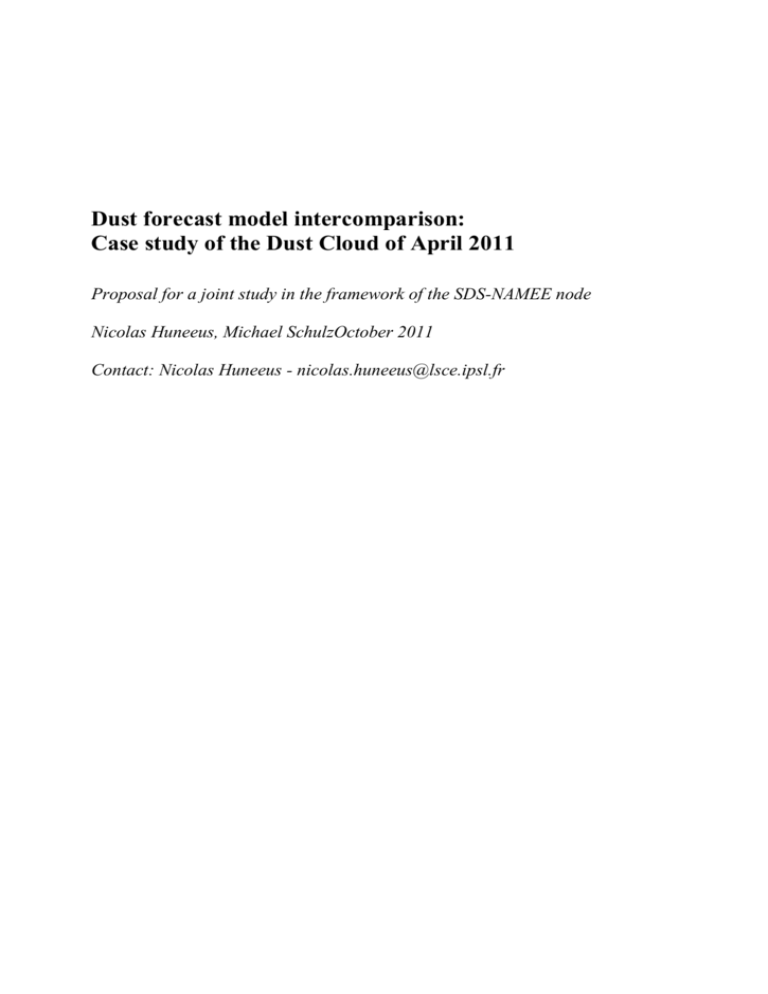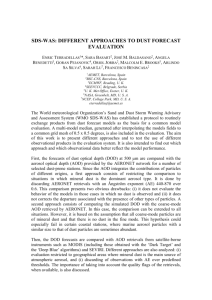Dust forecast model intercomparison - Northern Africa
advertisement

Dust forecast model intercomparison:
Case study of the Dust Cloud of April 2011
Proposal for a joint study in the framework of the SDS-NAMEE node
Nicolas Huneeus, Michael SchulzOctober 2011
Contact: Nicolas Huneeus - nicolas.huneeus@lsce.ipsl.fr
Motivation
Mineral aerosols play an important role not only in the climate system but also for
regional air quality in different parts of the globe (Kim et al., 2001; Ozer et al., 2007;
Jimenez-Guerrero et al., 2008). To improve the capabilities to forecast sand and dust storms
the World Meteorological Organization (WMO) created the Sand and Dust Storm Warning
Advisory and Assessment System (SDS-WAS). A specific task in this framework concerns
the evaluation of dust forecast models with observations. Such evaluation can be done on
several time scales. Within the SDS-WAS node on Northern Africa-Middle East-Europe
(NAMEE) several attempts are underway to perform model evaluation and intercomparison
between different models contributing to the SDS activities.
As a contribution to the activities of the SDS-WAS NAMEE node we intend to
complement its effort by conducting a case study where different dust forecast models are
compared against observations for a given dust event, which occurred in April 2011. We are
interested in exploring the differences between the models to simulate different datasets and
identify whether this is due to vertical profile, optics, size distribution, removal fluxes, wind
fields or other model characteristics or processes. Studying a specific dust event allows to also
investigate on higher time frequency of a few hours the capacity of the models to predict the
approach of a dust event.
The ability of models to reproduce the onset and durations but not the magnitude of a
given dust events has already been documented by Uno et al. (2006). The authors in this paper
compared multiple regional dust models over Asia in connection to specific dust events and
among the results are that even though the models were able to reproduce surface
measurements, large differences existed among them in processes such as emissions, transport
and deposition. Similar results were presented by Todd et al. (2008). The authors conducted
an intercomparison with five regional models for a 3-day dust event over the Bodélé
depression. Yet none of these studies considered forecast outputs nor did they compared the
effect of increasing forecast time step in the performance to reproduce the observations
associated to a given dust event.
Intercomparison
The selected dust event corresponds to the one which occurred between the 5th and 7th
of April of 2011. Dust was blown out over Morocco and Algeria on the 5th of April and
reached the coast of Portugal the next day. The dust cloud continued to be transported to the
northeast reaching Scandinavia on April the 10th (Figure 1). Multiple AERONET stations in
Spain showed an increase in aerosol optical depth (AOD) at 550 nm between the 6th and the
9th of April (Figure 2). The dust cloud was observed by multiple satellites and red rain in
Northern Scandinavia could be traced back to this cloud.
As a first step, we have compared the AERONET AOD at these stations to ECMWF
model output using the 24, 48 and 72 hours forecast time steps from three consecutive
forecasts run by the experimental ECMWF MACC model version running in assimilation
mode (Figure 2). The different forecasts reproduce the onset and duration of the event at each
AERONET station. The largest bias with respect to the observations appears in days when the
dust cloud passed the Aeronet sites. All forecasts have difficulties to reproduce the magnitude
during the event and the discrepancy increases for a larger forecast time step.
We will extend this analysis to AERONET stations affected by this dust event outside
of Spain. Furthermore, we will also compare each forecast output to in-situ measurements of
surface concentration (PM) and satellite retrieved AOD (MODIS, MISR, PARASOL) and
vertical profiles of aerosol extinction (Caliop). In addition we intend to explore the
application of statistical skill scores to evaluate model performance. The use of skills is
widely used in the Numerical Weather Prediction (NWP) community and Regional Air
quality and it might be useful to apply some of these skills to the forecast of dust events.
The evaluation of several models and eventual different model versions is crucial to
better understand the reason of individual model performance for a big event like the one
proposed to be studied here. Model groups who are interested to join this study are asked to
consider if model data for the period of April 2011 can be made available.
Variables of interest and file convention for model data intended to
contribute to the study
For the above proposed analysis we make use of the tools developed in the framework
of the AeroCom project. To facilitate the intercomparison and application of the above
mentioned tool, the data have to follow the AeroCom conventions. The format of the data
files has to be NetCDF and each variable has to be saved in a different file. The output
frequency has to be 3 hourly and all variables have to be instantaneous with the units as
indicated in parenthesis next to each variable in the list below. The emission fluxes have to be
also provided as accumulated within the 3-hour period. For practical reasons we ask for the
entire month of April of 2011 and the 24 hr forecast has to be up to 72 hours starting each day
at 00UTC. Each daily forecast shall be contained in one file.
Models which may not provide all diagnostics are kindly asked to contact Nicolas
Huneeus.
The files for each variable have to be named according to the following guideline:
{Model_Name}.3hourly.{Variable_Name}.{Year}.{Day}.nc
The variables of interest and variable names in parentheses are:
2D Total AOD@550nm (od550aer)
2D Dust AOD, total and fine mode (<1um) or per bin (od550dust, od550lt1dust)
3D aerosol and dust extinction @550nm (ec5503daer, ec5503ddust)
Wind at 10m (zonal and meridional) [m/s] (uas,vas)
3D wind field [m/s] (uas,vas)
2D Surface dust concentration, total and fine mode or per bin. [g/m3]
(sconcdust,sconclt1dust)
2D Total aerosol load [kg/m2] (loaddust)
3D Dust mixing ratio for all dust tracers in model [kg/kg] (mmrdust01...04)
(accompanied by ascii readme file on how to recompute aerosol size)
2D Emission fluxes, both total and per bin/mode [kg/m2/s]
2D Removal fluxes (wet & dry), both total and per bin/mode [kg/m2/s]
3D Temperature, Relative humidity and Pressure fields at surface and 500 hPa.
Soil characteristics
References
Jimenez-Guerrero, P., Perez, C., Jorba, O., and Baldasano, J. M.: Contribution of Saharan dust
in an integrated air quality system and its on-line assessment, Geophys. Res. Lett.,
35(3), L03814, doi:10.1029/2007GL031580, 2008.
Kim, K. W., Kim, Y. J., and Oh, S. J.: Visibility impairment during Yellow Sand periods in
the urban atmosphere of Kwangju, Korea, Atmos. Environ., 35(30), 5157–5167, 2001.
Ozer, P., Laghdaf, M., Lemine, S. O. M., and Gassani, J.: Estimation of air quality
degradation due to Saharan dust at Nouakchott, Mauritania, from horizontal visibility
data, Water Air Soil Pollut., 178(1–4), 79–87, 2007.
Todd, M. C., Karam, D. B., Cavazos, C., Bouet, C., Heinold, B., Baldasano, J. M., Cautenet,
G., Koren, I., Perez, C., Solmon, F., Tegen, I., Tulet, P., Washington, R., and Zakey, A.:
Quantifying uncertainty in estimates of mineral dust flux: An intercomparison of model
performance over the Bodele Depression, northern Chad, J. Geophys. Res.-Atmos., 113,
D24107, doi:10.1029/2008JD010476, 2008.
Uno, I., Wang, Z., Chiba, M., Chun, Y. S., Gong, S. L., Hara, Y., Jung, E., Lee, S. S., Liu, M.,
Mikami, M., Music, S., Nickovic, S., Satake, S., Shao, Y., Song, Z., Sugimoto, N.,
Tanaka, T., and Westphal, D. L.: Dust model intercomparison (DMIP) study over Asia:
Overview, J. Geophys. Res.-Atmos., 111(D12), D12213, doi:10.1029/2005JD006575,
2006.
Figure 1: OMI Aerosol Index images between 5 and 10 of April 2011.
Figure 2: Aerosol optical depth (AOD) at 550 nm between the 1 st and 10th of April 2011 at Spanish AERONET
stations. AERONET AOD (blue) and model output at 24 (red), 48 (black) and 72 (green) hours forecast.





